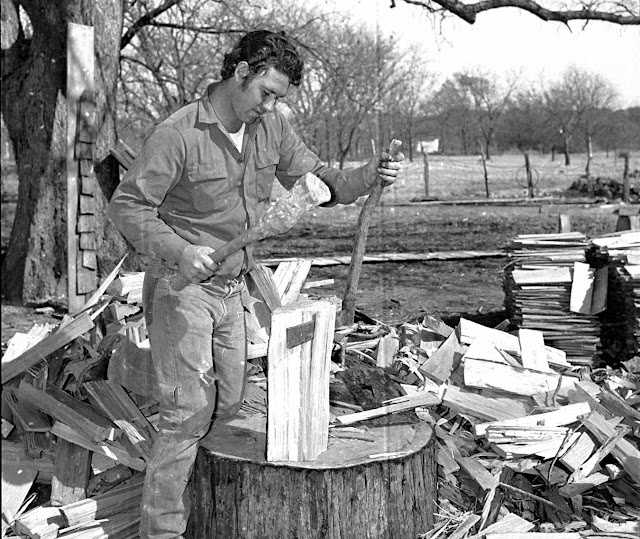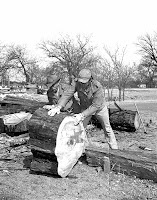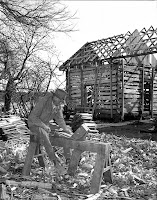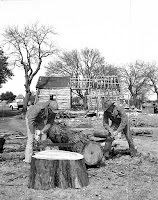 |
| Using a maul and froe to make shingles. Click on any image to enlarge. |
The Salter family published the Kerrville Mountain Sun for three generations, and Forrest Salter placed an ad in his family's newspaper seeking "information on shingle making and the names of any pioneer resident of this section who has seen shingles made in the camps along the Guadalupe River. Please send name or information to The Mountain Sun office."
The resulting story is fascinating and provides details about shingle making I've never seen anywhere else.
One of the individuals Salter interviewed was A. P. "Potter" Brown, the youngest son of Joshua and Sarah Brown. Joshua Brown is the founder of Kerrville, and gave the land for the first county seat in 1856. He came to Kerr County in the late 1840s to harvest the cypress trees along the river and make shingles from them.
Potter Brown described how shingles were made:
"One of the first things the men had to have was a good shingle knife, which was hand-made of iron. The blade was about one quarter inch thick and about twelve inches long. You see, the width of the shingle depended upon the length of the shingle knife. At one end was a loop or ring in the iron, and in this was put a round handle, smoothed down so the palm of the hand would not blister. The handle was about six to nine inches long, and about an inch through, just big enough for a man to get a good 'hand holt' as he used it. The knife was held in the left hand while a wooden mallet, used to hammer the knife down on the block of wood, was wielded with the right.
 "Groups of two men would use a big cross-cut saw, or sometimes a good sharp axe, to cut the cypress trees, and then when the logs had been trimmed, they would be cut into convenient sized chunks and hauled or dragged to the camp. The trees were so big that sometimes men could work a whole season on the timber in their neighborhood, and feel free, because the Indians did not come around so often when a settlement had been established.
"Groups of two men would use a big cross-cut saw, or sometimes a good sharp axe, to cut the cypress trees, and then when the logs had been trimmed, they would be cut into convenient sized chunks and hauled or dragged to the camp. The trees were so big that sometimes men could work a whole season on the timber in their neighborhood, and feel free, because the Indians did not come around so often when a settlement had been established."Some of the men had shingle horses, a contraption made of a few poles and slabs. It had a mouth where the shingle slab fitted, and when the slab had been placed in the mouth, the 'draw knife' was pulled across the length, giving the shingle the sloping sides which made it possible for them to overlap on a roof. These 'draw knives' were kept razor-sharp, and unlucky was the inquisitive visitor whose hand happened to touch one of their sharp blades. Mud, leaves, or sometimes sawdust was used to stop the blood when such a hand was badly cut.
 "The camp was usually under a brush arbor, where the limbs from the Spanish oak, the sycamore, or some other brushy-topped tree was used as protection from the sun. The shingles were put in bundles and tied together with rawhide most of the time, as nails for crating were too precious for use.
"The camp was usually under a brush arbor, where the limbs from the Spanish oak, the sycamore, or some other brushy-topped tree was used as protection from the sun. The shingles were put in bundles and tied together with rawhide most of the time, as nails for crating were too precious for use."You know, son," Potter Brown concluded, "some of these old abandoned farm houses in the Turtle Creek section still have these hand-made shingles on their roofs."
Forrest Salter interviewed others, too, in addition to Potter Brown. His story includes quotes from Mollie Goss, Mrs. L. C. Watkins, Mr. and Mrs. Dan Rees, Mrs. Fritz Schmidt, and Sarah Surber. Each contributed interesting facts to Salter's story. Click here to download and read Forrest Salter's story in full.
Until next week, all the best.
Joe Herring Jr. is a Kerrville native who thinks shingle making would be a lot of hard work. This column originally appeared in the Kerrville Daily Times November 3, 2018.



No comments:
Post a Comment
Please remember this is a rated "family" blog. Anything worse than a "PG" rated comment will not be posted. Grandmas and their grandkids read this, so please, be considerate.